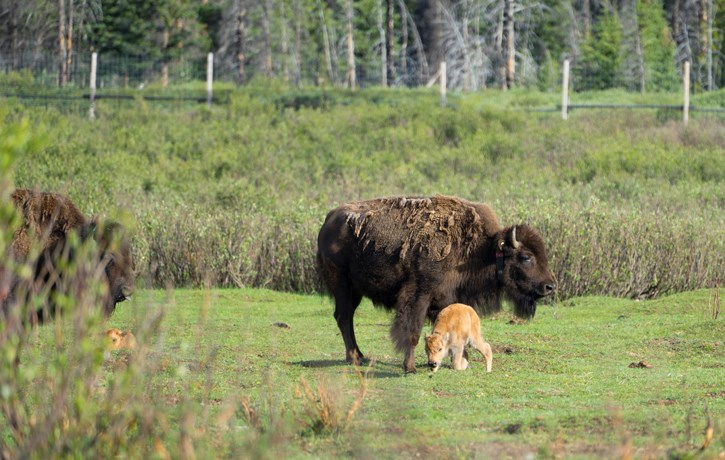BANFF – Three bison calves have been born in Banff’s backcountry, bringing the herd’s size to 29.
Nine of the 10 female bison were pregnant this year and, with three calves born, there’s potential for six more in the coming weeks.
Parks Canada officials say these are the first bison conceived in the park in more than 140 years, noting the 10 calves born last year were conceived in Elk Island National Park.
“The calves are doing well and were up and around right away. They look good and healthy and are nursing well,” said Bill Hunt, resource conservation manager for Banff National Park.
“We’d expect more calves in the near future, but they are wild animals and who knows if all will be successful in bringing calves into the world? We’ll have to wait and see.”
One of the calves was born on July 19 while the other two were born four days earlier.
In February 2017, 10 pregnant cows and six bulls were brought to the Panther Valley from a disease-free herd at Elk Island National Park as part of an ambitious $6.6 million reintroduction plan.
The animals were placed in an 18-hectare fenced pasture in the Panther Valley, about 40 kilometres north of the Banff townsite.
Last spring, all 10 females gave birth and all calves – seven females and three males – survived their first year.
This is the herd’s second calving season in the soft-release pasture, and it’s one of the main ways Parks Canada helps bond them to their new home range. Bison tend to return to the same areas to calve each spring.
By holding them for two calving seasons in the heart of the reintroduction zone, it is hoped the herd will adopt this area as their annual calving ground.
Hunt said gates to the fenced pasture will be opened soon to release the bison into into a larger, 1,200 square kilometre reintroduction zone in the Panther and Dormer valleys.
He said they are not necessarily waiting for the last calf to drop before releasing the herd, but keeping an eye on water levels in the region.
“We’re watching water levels because, of course, it exposes them to the Panther River,” said Hunt.
Approximately eight kilometres of adjustable fencing has been installed in 15 different locations in an attempt to keep the animals inside the larger bison zone.
Parks Canada doesn’t want the herd wandering onto provincial land where they may be killed, or to more developed areas of Banff National Park.
GPS collars have been put on adult bison and ear tag transmitters on last year’s calves in preparation for the release in the coming weeks.
Monitoring the satellite collars, Parks Canada will keep tabs on bison and herd, haze, or bait them as necessary to help steer their movements to encourage them to develop an affinity within their new home range.
Hunt said a 315-hectare prescribed fire was completed in the reintroduction area in May to help restore native grasslands and create lush new habitat.
“We hope to shepherd them into those areas and show them good summer range,” he said. “Then, later into fall, show them an area further down valley where there’s good habitat for winter.”
Wolves have been aware of the bison herd in the fenced pasture, and more recently a grizzly bear wandered by.
“The bear and bison surprised each other on either side of fence and then ran off in opposite directions,” Hunt said. “They looked back as if to say, ‘what are you?’ ”
Researchers are interested to see if wolves change their prey preference.
Research in Yellowstone National Park following the reintroduction of wolves in 1995 gave biologists a unique opportunity to study predator-prey interactions.
The type of prey killed by wolves there varies by time period and consists primarily of elk. However, research shows predation on other prey such as bison may be increasing.
Research in Yellowstone suggests wolves often pick their prey based on the size of their pack. They generally eat elk, but bigger packs will tackle bison.
“I think it will take wolves here a while to determine whether bison are something they’re interested in or not,” said Hunt. “But once the gates open, nature will take its course.”
In 2022, Parks Canada will assess whether to continue or abandon the project.
For thousands of years, plains bison roamed the plains of North America. Their numbers were as large as 30 million, but bison nearly went extinct in the 19th Century within a single human lifetime due to overhunting and slaughter.




